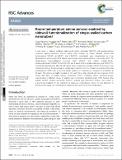| dc.contributor.author | Paoletti, Clara | |
| dc.contributor.author | He, Maggie | |
| dc.contributor.author | Salvo, Pietro | |
| dc.contributor.author | Melai, Bernando | |
| dc.contributor.author | Calisi, Nicola | |
| dc.contributor.author | Mannini, Matteo | |
| dc.contributor.author | Cortigiani, Brunetto | |
| dc.contributor.author | Bellagambi, Francesca G. | |
| dc.contributor.author | Swager, Timothy M. | |
| dc.contributor.author | Di Francesco, Fabio | |
| dc.contributor.author | Pucci, Andrea | |
| dc.date.accessioned | 2020-04-24T18:45:17Z | |
| dc.date.available | 2020-04-24T18:45:17Z | |
| dc.date.issued | 2018-02 | |
| dc.date.submitted | 2017-12 | |
| dc.identifier.issn | 2046-2069 | |
| dc.identifier.uri | https://hdl.handle.net/1721.1/124867 | |
| dc.description.abstract | A new series of sidewall modified single-walled carbon nanotubes (SWCNTs) with perfluorophenyl molecules bearing carboxylic acid or methyl ester moieties are herein reported. Pristine and functionalized SWCNTs (p-SWCNTs and f-SWCNTs, respectively) were characterized by X-ray photoelectron spectroscopy (XPS), Raman spectroscopy and scanning electron microscopy (SEM). The nitrene-based functionalization provided intact SWCNTs with methyl 4-azido-2,3,5,6-tetrafluorobenzoate (SWCNT-N-C[subscript 6]F[subscript 4]CO[subscript 2]CH[subscript 3]) and 4-azido-2,3,5,6-tetrafluorobenzoic acid (SWCNT-N-C[subscript 6]F[subscript 4]CO[subscript 2]H) attached every 213 and 109 carbon atoms, respectively. Notably, SWCNT-N-C[subscript 6]F[subscript 4]CO[subscript 2]H was sensitive in terms of the percentage of conductance variation from 5 to 40 ppm of ammonia (NH[subscript 3]) and trimethylamine (TMA) with a two-fold higher variation of conductance compared to p-SWCNTs at 40 ppm. The sensors are highly sensitive to NH[subscript 3] and TMA as they showed very low responses (0.1%) toward 200 ppm of volatile organic compounds (VOCs) containing various functional groups representative of different classes of analytes such as benzene, tetrahydrofurane (THF), hexane, ethyl acetate (AcOEt), ethanol, acetonitrile (CH[subscript 3]CN), acetone and chloroform (CHCl[subscript 3]). Our system is a promising candidate for the realization of single-use chemiresistive sensors for the detection of threshold crossing by low concentrations of gaseous NH[subscript 3] and TMA at room temperature. | en_US |
| dc.description.sponsorship | National Science Foundation (U.S.) (DMR-1410718) | en_US |
| dc.description.sponsorship | Italy. Ministero dell’istruzione, dell’università e della ricerca (PRIN 2010-2011) | en_US |
| dc.description.sponsorship | Università di Pisa (MIT-UNIPI) | en_US |
| dc.language.iso | en | |
| dc.publisher | Royal Society of Chemistry (RSC) | en_US |
| dc.relation.isversionof | http://dx.doi.org/10.1039/C7RA13304A | en_US |
| dc.rights | Creative Commons Attribution 3.0 unported license | en_US |
| dc.rights.uri | https://creativecommons.org/licenses/by/3.0/ | en_US |
| dc.source | Royal Society of Chemistry (RSC) | en_US |
| dc.title | Room temperature amine sensors enabled by sidewall functionalization of single-walled carbon nanotubes | en_US |
| dc.type | Article | en_US |
| dc.identifier.citation | Paoletti, Clara, et al. “Room Temperature Amine Sensors Enabled by Sidewall Functionalization of Single-Walled Carbon Nanotubes.” RSC Advances 8, 10 (2018): 5578–85. © 2018 The Royal Society of Chemistry | en_US |
| dc.contributor.department | Massachusetts Institute of Technology. Institute for Soldier Nanotechnologies | en_US |
| dc.contributor.department | Massachusetts Institute of Technology. Department of Chemistry | en_US |
| dc.relation.journal | RSC Advances | en_US |
| dc.eprint.version | Final published version | en_US |
| dc.type.uri | http://purl.org/eprint/type/JournalArticle | en_US |
| eprint.status | http://purl.org/eprint/status/PeerReviewed | en_US |
| dc.date.updated | 2020-01-14T13:41:55Z | |
| dspace.date.submission | 2020-01-14T13:41:57Z | |
| mit.journal.volume | 8 | en_US |
| mit.journal.issue | 10 | en_US |
| mit.metadata.status | Complete | |
